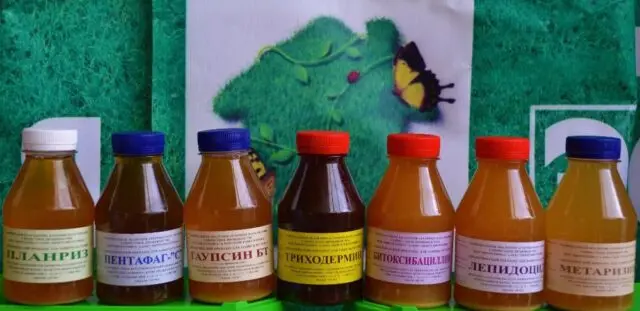Contents
Mildew on grapes is one of the most common fungal diseases of the crop. Downy mildew came to Europe from North America as early as 1878. If you do not fight the disease, then you can lose not only the crop, but also the vine itself.
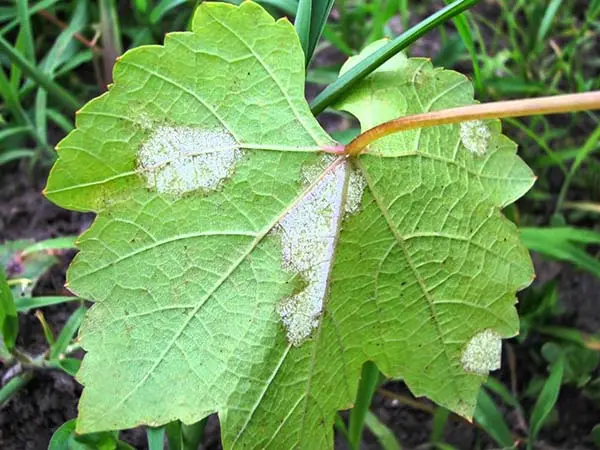
The first spring rain can bring mildew fungus from neighboring areas
What is this disease and why is it dangerous
American grape mildew disease occurs in all vineyards in the world. Downy mildew does not happen, perhaps, only in Central Asia, since there is no rain in this region in summer.
The causative agent of the disease is the fungus Plasmopara viticola, for the development of which living plants are needed. Downy mildew spreads to plantations very quickly, so it is important not to miss the deadlines for prevention. The spores overwinter in the soil and retain their vitality for up to five years.
Downy mildew is dangerous for grapes, because 16 generations of the fungus develop in one season. There are other reasons why you need to deal with mildew:
- pests and parasites quickly settle on diseased plants;
- crop losses in the year of defeat and in the next season increase to 50%;
- berries are practically unsuitable for processing;
- from a vine affected by downy mildew, it is impossible to harvest cuttings;
- plants weakened by the disease do not winter well.
The first symptoms
Growers should be aware of the signs of downy mildew in order to immediately start fighting it before it hits all plantings. The disease can be recognized by the following symptoms:
- “fatty” yellowish spots appear on the upper part of the spreading leaf;
- on the reverse side of the affected area, a white fluff, similar to flour.
After some time, the foliage dies off, then crumbles. Moreover, downy mildew affects not only the leaves, but also the vine, and then the berries. First they turn blue, then darken (turn brown) and wrinkle, becoming unusable.
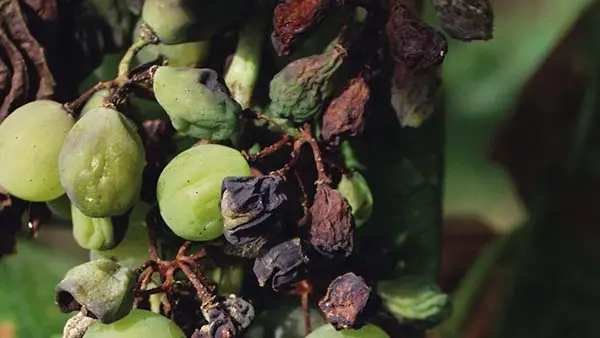
“Skinny” berries appear on clusters due to mildew
Difference from other diseases
There is another disease with a similar name “powdery mildew”. This is an oidium grape. It is also capable of destroying almost the entire crop crop. But the difference is that it can be recognized by a whitish coating, but not from the back, but from the top of the leaf blade. It’s not oily and wipes off easily. And already under the plaque are brown spots.
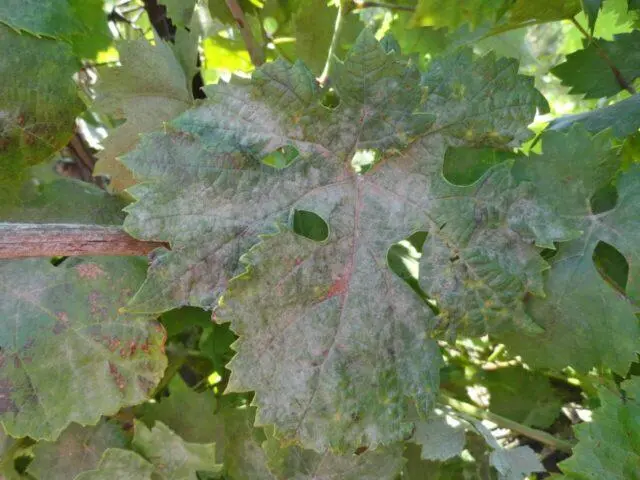
You can understand that oidium disease develops on the vine by the smell of rotting fish
Causes
The causative agent of mildew is the powdery mildew fungus Plasmopara viticola, which forms zoospores. They are carried by the wind over long distances, and damp and warm weather (8-24 ° C) contributes to the development of spores. Downy mildew affects only the living tissues of the plant.
In hot, dry weather, zoospores die. Mildew has its own incubation period, which is determined by months:
- May, middle – from 15 to 18, end of the month – 12-15 days;
- June, beginning – 12-14, second half – 9-10, last decade – up to 7 days;
- July, August – from five to six days.
How to deal with mildew on grapes
At the first sign of downy mildew, you need to urgently treat the plantings. To do this, you can use folk or special means. Each of them is good in its own way. Folk remedies are less effective, but safe, they can be used at any time, even when the crop is ripe.
Folk remedies for mildew on grapes
There are different ways to deal with mildew, which have been created and used for centuries. All these drugs are safe not only for humans, but also for insects.
Wood Ash
To spray 1 kg of ash, pour 10 liters of water, insist for three days. Then filter, add three tablespoons of liquid soap. Use immediately. You can repeat every week.
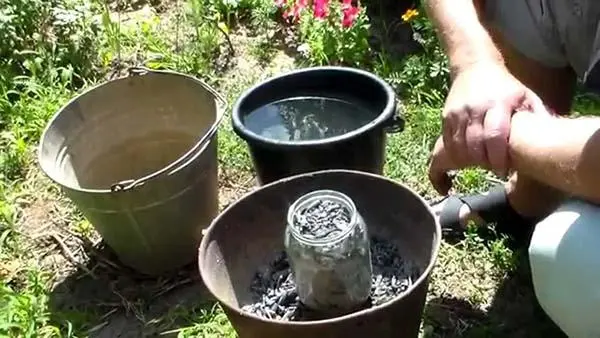
Many growers sprinkle dry wood ash on their plantings.
Soda
Baking soda or soda ash has long been used to control downy mildew. About 10 g of powder are dissolved in 50 liters of water and 50 g of laundry or green soap are added.
Soda, iodine and manganese
This solution is prepared from 4 tbsp. l. soda, which is dissolved in warm water. Up to 20 drops of iodine are added there. Everything is mixed in 10 liters of water, a little potassium permanganate and 3 tbsp. l. liquid soap (for sticking solution). Spray grapes from mildew before flowering in cloudy dry weather. Repeat every seven days.
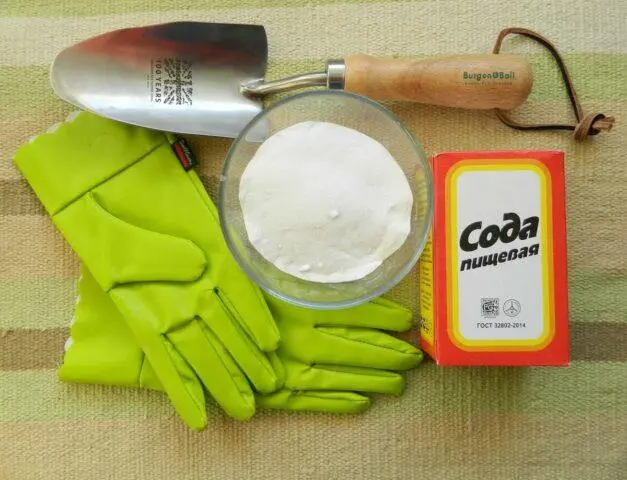
Soda is one of the indispensable means to combat fungal diseases on grapes.
Pretender hay
Put it in warm water and insist five days for the formation of hay bacillus, which Plasmopara viticola is afraid of. The mother liquor is diluted in a ratio of 1:3. Process grape bushes from mildew all season in ten days.

The bucket needs to be filled with rotten hay, and only then add water, keep in a warm place
Dairy products
Sour milk, whey is a great option to combat mildew and oidium grapes. Powdery mildew does not like the effects of an acidic environment at all.
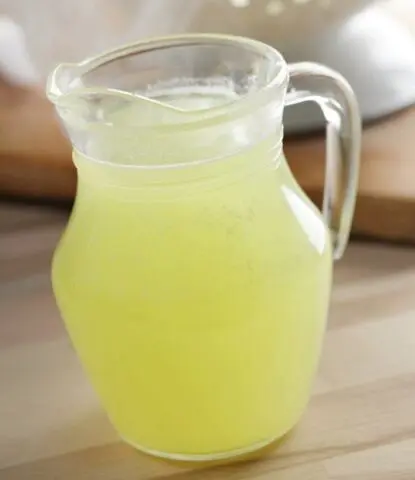
Add 10 liter of serum and liquid soap to a 1-liter bucket so that the solution stays on the plant longer
Infusion horsetail
Many gardeners know this weed and remove it from the site. In fact, the plant helps in the fight against mildew. To obtain a solution, take 100 dry horsetail and boil in 5 liters of water. After 12 hours, the infusion is filtered, combined with 50 g of liquid soap and plantings of grapes infected with mildew are sprayed.
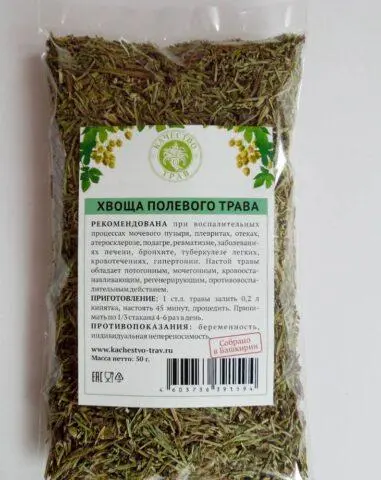
Horsetail grass is sold in any pharmacy
Infusion fermented sour bread
Many growers use fermented black bread to treat mildew on grapes. 1 kg of dry crusts pour 10 liters of warm water, add 2 tbsp. l. granulated sugar and insist 4-5 days. During this time, the liquid will begin to ferment. The resulting acidic environment with yeast fungi adversely affects mildew.
Before spraying, the infusion should be diluted with water at room temperature in a ratio of 1:3.
Dill
Some winegrowers hold dill in special esteem. They plant this fragrant plant around the entire perimeter of the vineyard. In fact, dill does little to help with downy mildew on grapes.
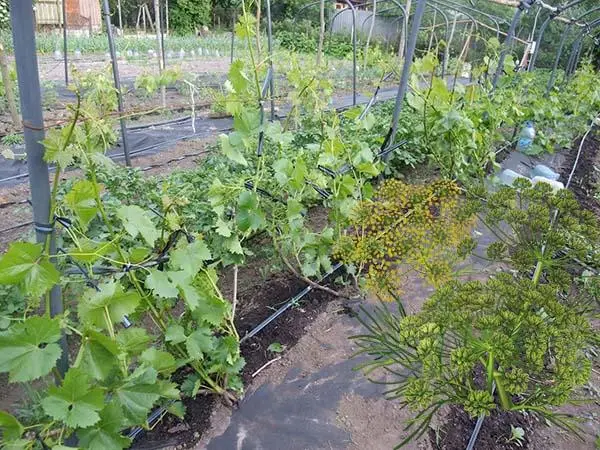
Planting dill will not harm the grapes, so you can grow it next to the vine
Preparations for mildew on grapes
Folk remedies for downy mildew are often used for prevention even when mildew has just appeared on grapes (isolated cases). If the defeat is massive, then you will have to use special formulations to rid the grapes of downy mildew.
Mildew medications can be:
- Systemic. They are used not only for protection against mildew, but also for treatment. The drugs act on the disease “from the inside”, so that no rain can wash them away.
- Contact. These chemicals destroy the mildew in the places where they were applied. Therefore, when working with them, you need to achieve a thorough “washing” of all the affected parts of the plants.

Any chemical preparations must be used strictly for their intended purpose.
- Biological. These are most often preventive drugs that can be used even at the stage of berry formation.

In order not to harm, you need to carefully study the recommendations on the package
Agrotechnical measures
Most often, downy mildew breaks out on young plantings of grapes, because they have low immunity. Sometimes folk recipes and chemicals are enough. Often the health of the vine largely depends on timely agrotechnical measures.
Agrotechnical measures against mildew:
- For grapes, ventilated areas are chosen, and the rows are arranged so that they coincide with the direction of the winds.
- The vine is tied up and thinned out to allow air to circulate.
- Be sure to feed the grapes with fertilizers containing potassium and phosphorus, and in the fall they add a bucket of wood ash.
- Mildew-resistant grape varieties are planted.
- They do not allow the growth of weeds, loosen the soil throughout the season.
- All cut parts of the grapes, which show signs of mildew, are removed from the site and burned.
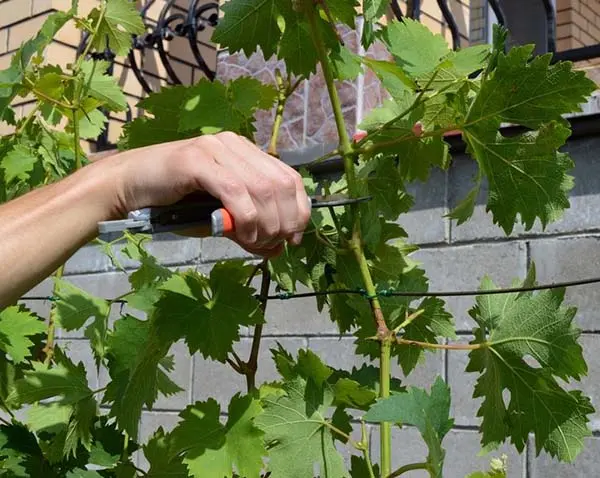
Pasynkovanie, pruning and chasing grapes should be carried out throughout the growing season
Preventive treatment of grapes from mildew
Prevention of mildew and other fungal diseases is necessary for grape plantings. Some of them are in the spring, some in the fall. In case of infection, it will no longer be necessary to prevent, but to specifically treat the grapes.
How to process grapes in the spring from mildew
In the spring, it is important to have time to process the vine from downy mildew before the first rain. For spraying plantings and soil, Nitrofen is used, which is bred strictly according to the instructions.
When four leaves appear, Ridomil is bred, and before the formation of brushes, clusters are sprayed with Bordeaux liquid.
Processing grapes in autumn from mildew
Since grape mildew spores do not die in the wintering phase, it is necessary to carry out autumn work to prevent fungal diseases.
Stages of work:
- Foliage and mildew affected parts of grapes are collected in a heap and set on fire.
- The soil and plantings are sprayed with copper or iron sulphate.
- Depending on the region, the vine is covered for the winter.
Mildew resistant grape varieties
There are not many grape varieties that are resistant to downy mildew. It is better for gardeners to start with representatives of the culture with high immunity to fungal diseases.
Resistant varieties:
- Victoria, Friendship;
- December, Pearl pink;
- Khasanskiy Bousa, Khasanskiy sweet;
- Super Extra, Bianchi.
It is important to first carefully read the description and characteristics of grape varieties.
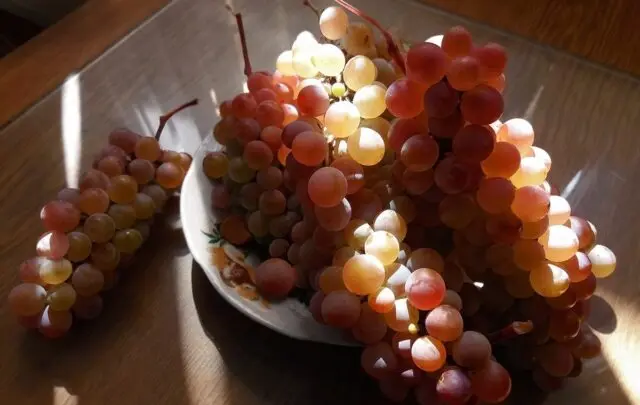
The grape variety Dneprovsky pink is also resistant to mildew.
Conclusion
Mildew on grapes, like oidium, can be cured, the main thing is not to be late with events. Plantings should be carefully inspected so as not to miss a whitish fluff on the upper or lower side of the leaf blade.











